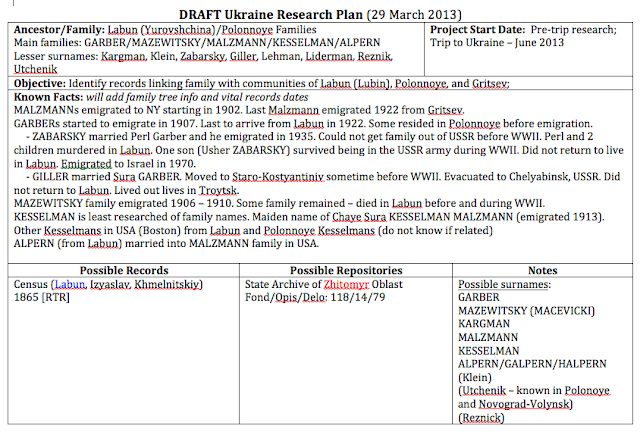In the meantime, here is a concept map of the planned trip. I say "concept" because while we will pretty much take these routes, there is flexibility built into the schedule and things may change.
 |
| Map constructed in Google Maps, 26 May 2013 |
Our journey will start in the Galicia section of Ukraine, part of the former Austro-Hungarian Empire. We will arrive in Lviv (A) about mid-day on 3 June. The next day we will head to Yaremche (B) with Alex Dunai (our genealogist, translator and guide) to take in Hutsel culture. I had hoped to hike Mt. Hoverla, the highest point (6762 feet) in Ukraine, but we've already had to change that plan due to a foot injury Katherine, my daughter, suffered yesterday.
After at least looking at Mt. Hoverla we'll wend our way back to Lviv through the Carpathian Mountains. We will stop at Bolekhiv (C), the shtetl that Daniel Mendelsohn wrote about in his book The Lost: A Search for Six of Six Million. I am finally getting around to reading it. Alex Dunai is featured as Mendelsohn's Ukrainian genealogist.
My first family shtetl stop will be at Skole (D). Skole is the place where Jutte Ett Barath was born on 21 January 1894 and where, her mother (also mother of David Ett, and Sophie Ett Leiner, Sarah Ett Cohn, and Chaitze Ett Rappaport) Perl Wenkert Ett died on 18 August 1895.
We will then spend a couple of days seeing the sites of Lviv and working in the archives. Records will likely be in Polish script. I have been reviewing "Reading Polish Handwritten Records," a 3-part tutorial in the Learning Center on FamilySearch.org.
After Lviv, we will once again head south to continue treading the ground where my Wenkert and Liebross (maternal) relatives trod: Kolomyya (E), Chernivtsi (G) and Zalishchyky (F), Ustechko and Torskie. By the way, I have not been able to put Ustechko on the above map (I didn't even attempt mapping Torskie!). Each time I ask Google Maps to include Ustechko, Google places a dot north of Ternopil - way off from Ustechko's actual location just north of Zalishchyky. So, I had Google Maps place a dot near Chortkiv (H), which is a little north of Ustechko.
I am really looking forward to Kamyanets-Podilskyy (I). The photos I've seen indicate a picturesque location: a walled town with a castle. One of my floater "relatives," Samuel Myers (nee Zise Malzmann) lived in K-P before emigrating to the United States.
Visits to the archives in Khmelnitsky (J) and Zhytomir (O) will mark my entrance to the old Russian Empire and Volhynia Gubernia and my father's side of the family (Garber, Mazewitsky/Morris, Malzmann, and Kesselman). The Family History Library has been unable to film any records for Yurovshchina [once Labun (K) and Lubin], Gritsev (M) and Polonnoye (L). These towns, having been neither part of Poland nor the Austro-Hungarian Empire since about 1795 , have no records in the Warsaw archives (accessible to JRI-Poland). So, the best bet is checking the Ukrainian Archives. The records will likely be in Russian script. I'm working on understanding that, too.
I hope to not only find family records but to locate village records for Labun, Gritsev, Polonnoye and Baranovka that may be acquired, perhaps at a later date, for use by other Jewish researchers.
I'm trying not to be too excited about setting foot in Yurovshchina. I just don't know what to expect. But I will come prepared with early 20th Century maps for comparison sake and a photo the the bath house (pictured here) repaired with the American Joint Distribution Committee's help in 1923. I'd like to see if we can locate where it was located in the town. I want to know where the Jewish section was. I want to visit the cemetery - if there still is one. And I want to know where the Jewish people lived.
I know that many Jewish people were slaughtered along with their Jewish neighbors from Polonnoye in a location near Polonnoye. I want to go there, too.
I would like to visit Baranovka (N) so I can see the town where Feiga Grinfeld (Fannie Greenfield) was born. I've written so many posts about her, I've an investment (!).
We'll end our trip with a few days in Kiev (P) and then fly home on 22 June. I hope to have my iPad and Dropbox folders filled with photos to share. If all goes well, I'll be able to blog a bit about my trip as it happens. If not, I'll be sure to post quite a bit when I return to the United States.









